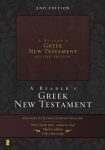 Deutsche Bibelgesellschaft recently published the 28th edition of Nestle-Aland’s Novum Testamentum Graece. This edition lists citations from the newly discovered Papyri 117-127, which is a significant addition for text critics. For instance, P127 (fifth-century) contains a text that differs greatly from Codex Vaticanus and Codex Bezae, revealing the most significant information we have for the development of Acts since the discovery of P38 in 1927 (D.C. Parker, ed., et al., The Oxyrhynchus Papyri, vol. 74, Graeco-Roman Memoirs, No. 95 [London: Egypt Exploration Society], 1-5). P117-126 also offers fresh new insights into the text of John (P119-122), Romans (P118) 1 Corinthians (P123), 2 Corinthians (P117, P124), 1 Peter (P125) and Hebrews (P126). All of this information is now made available for readers of the NA28.
Deutsche Bibelgesellschaft recently published the 28th edition of Nestle-Aland’s Novum Testamentum Graece. This edition lists citations from the newly discovered Papyri 117-127, which is a significant addition for text critics. For instance, P127 (fifth-century) contains a text that differs greatly from Codex Vaticanus and Codex Bezae, revealing the most significant information we have for the development of Acts since the discovery of P38 in 1927 (D.C. Parker, ed., et al., The Oxyrhynchus Papyri, vol. 74, Graeco-Roman Memoirs, No. 95 [London: Egypt Exploration Society], 1-5). P117-126 also offers fresh new insights into the text of John (P119-122), Romans (P118) 1 Corinthians (P123), 2 Corinthians (P117, P124), 1 Peter (P125) and Hebrews (P126). All of this information is now made available for readers of the NA28.
Some changes were made to the Catholic Epistles, based on text critical insights from the second edition of the Editio Critica Maior of the Greek New Testament , (ECM) a critical edition produced by the Institut für neutestamentliche Textforschungm. Most changes are insignificant, such as word order, addition of the article, etc. For instance, James 2:3 reads ἤ κάθου ἐκεῖ (NA28) instead of ἐκεῖ ἤ κάθου (NA27), and James 4:10 says τοῦ κυρίου (NA28), instead of κυρίου (NA27). Some changes are more significant, such as 2 Peter 3:10, which now reads οὺκ εὺρεθήσεται (“will not be found” supported by sa) instead of εὺρεθήσεται (“will be found” supported by א B, P, 1175 1448 1739txt 1852 syph mss txt syhmg). A full list of changes is found in the introduction. You can also find a list of examples here.
NA28 reflects the second edition of ECM in another manner. ECM provides a split guiding line, where editors remain undecided over certain readings. This split guiding line appears in NA28. For instance, readers can see that the editors of ECM struggled to decide between αύτὸ τοῦτο δὲ and αύτὸ δὲ τοῦτο in 2 Peter 1:5. A ♦ is placed in the text of NA28 before the disputed reading (♦ αύτὸ τοῦτο δὲ). The second reading appears in the apparatus with a ♦ before it also (♦ αυτο δε τουτο).
Another significant change is the abandonment of consistently cited witnesses of the first and second order. NA27 places manuscripts into these categories based on their value. Witnesses of the first order are considered highly valuable and are cited consistently for every textual problem. Second order witnesses are considered valuable only if they disagree with 𝔐. In other words, 𝔐 consists of Byzantine witnesses and second order witnesses, unless there is a disagreement between the two. Where the two disagree second order witnesses are cited explicitly in the apparatus. These categories create many uncertainties. For instance, it is difficult to determine why NA27 does not cite a witness of the second order. Did it agree with the Majority text? Or did it have a lacuna? NA28 solves this problem. Now, all witnesses cited consistently for every textual problem are listed in the apparatus. Witnesses not cited consistently are only listed in the apparatus if they have text-historical value.
Other changes include the abandonment of imprecise notes, such as pauci (pc) and ali (al), reduction and simplification of Latin abbreviations, increased precision in the citation of Greek manuscripts, and a thorough revision of cross-references to parallel texts. The NA28, with the dictionary, is currently available for $55.96 at the DTS Book Center. NA28 without the dictionary is available for $47.96. Navy and black leather bound editions are on sale for only $44.97 (list price $74.95). Offer good while supplies last. Come by and get your copy today.






 A Reader’s Hebrew and Greek Bible
A Reader’s Hebrew and Greek Bible Greek for the Rest of Us
Greek for the Rest of Us One of the most common questions that we receive here at the Book Center is this: What’s the difference between the NA27 and the UBS4 greek texts? Well, our friends over at
One of the most common questions that we receive here at the Book Center is this: What’s the difference between the NA27 and the UBS4 greek texts? Well, our friends over at 
